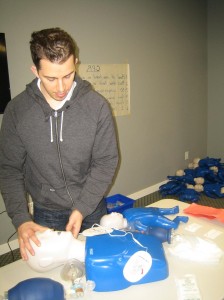Heart disease remains the number cause of mortality in the United States (and all over the world). CPR is the first line management for in and out-of-hospital cardiac arrest. Each year, the American Heart Association and other organizations train millions of people in CPR and first aid. It remains the most popular training program we have on offer – available through the week at various schedules.
You can sign up for certification through our provider websites, using the online form. The form is available all day and sends requests to use as soon as interested students press the submit button. However, we only process requests during normal business hours. We encourage interested students to send in e-mails, give calls, or visit us in person.
Studying CPR and first aid

CPR is made up for three skills – compressions, ventilation, and defibrillation. Compressions allow the heart to beat manually, and ventilations oxygenate the circulating blood. Defibrillation is only used to manage severe arrhythmias (not flatlines, medically called “asystole”), through the use of an automated external defibrillator.
When cardiac arrest happens, a person becomes unconscious and unresponsive to external stimuli. Because of the sudden loss of consciousness, a person typically get minor injuries such as bruises and cuts. However, more serious injuries can also happen to a victim such as concussions and burns. This is why first aid is included in all our training programs. We train students how to manage common injuries associated with sudden loss of consciousness
Training in the United States
Our training locations can be found in six cities in the country, spread out over five states. They all offer the same set of programs at the same rates, though schedules are dependent on the needs of our students. When our regular schedules cannot accommodate all the students, we open schedules during the evenings and weekends.
- California – Los Angeles CPR, San Francisco CPR
- Hawaii – Honolulu CPR
- Nevada – Las Vegas CPR
- Oregon – Portland CPR
- Washington – Seattle CPR
CPR and first aid training courses

CPR and first aid training courses are divided into basic CPR and advanced CPR. An additional category is for re-certification classes – training for the renewal of credentials approaching expiry.
- Advanced Cardiac Life Support (advanced CPR) – 16 hours
- Pediatric Advanced Life Support (advanced CPR) – 14 hours
- Basic Life Support for Health Care Providers (basic CPR) – 4.5 hours
- Basic Heartsaver (basic CPR) – 4.5 hours
- Basic Heartsaver C (basic CPR) – 4 hours
Certification and renewal
Certificates are valid for two years before they need to be renewed. Renewal can be done through re-certification classes. We have re-certification for ACLS, PALS, and Basic Life Support for HCPs. We remind our students to renew their credentials before they expire, because expired certificates are not eligible for a re-certification class.
